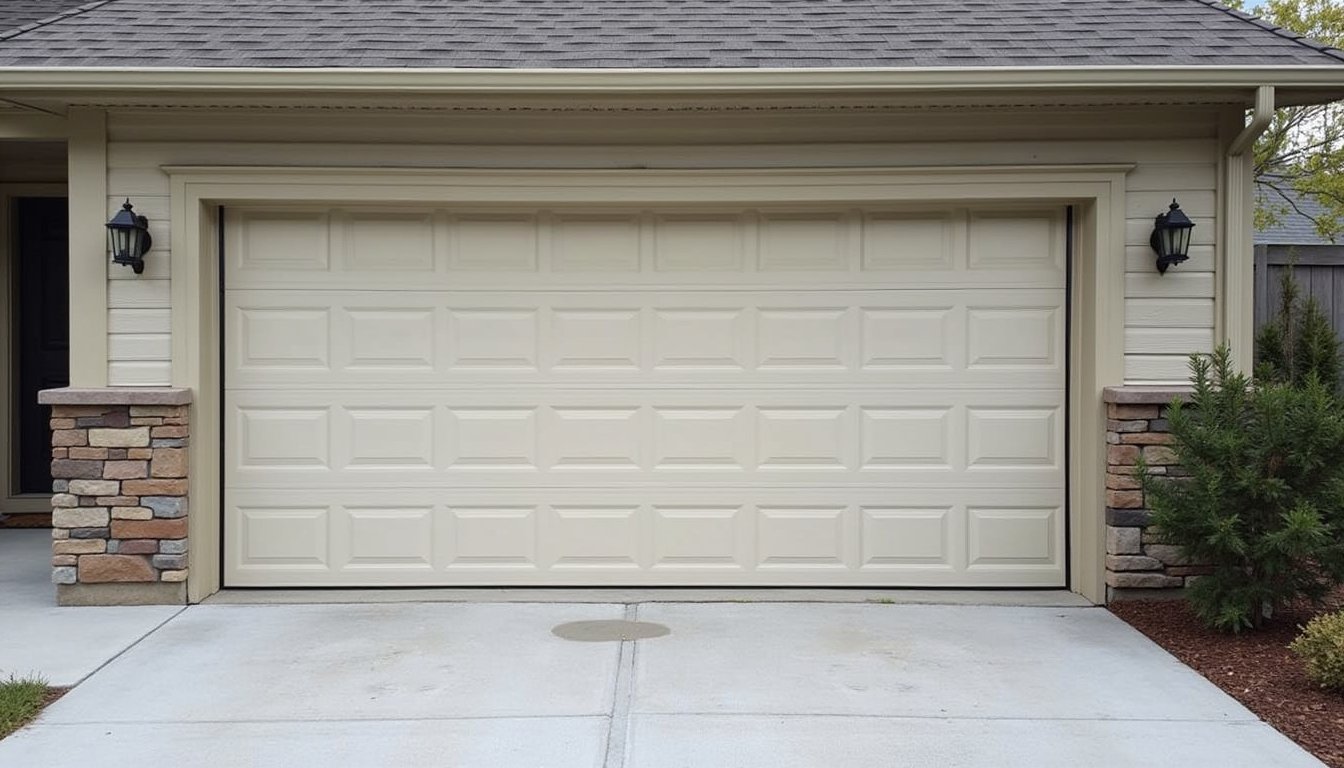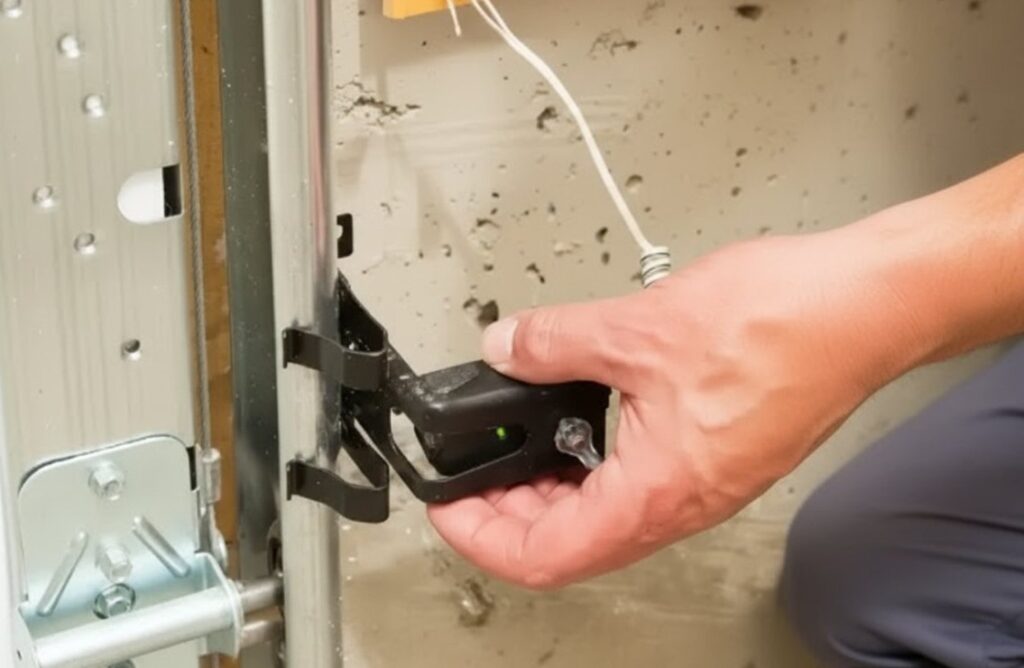When your garage door won’t close completely, it creates security risks and energy loss for your home. This comprehensive troubleshooting guide, presented by Eddie’s Garage Door Service in Tucson, Arizona, provides expert solutions to restore your door’s proper operation safely and efficiently.

Introduction: Common Garage Door Closing Problems
A garage door that won’t close all the way typically stems from safety sensor issues, track obstructions, or opener limit settings. Modern garage doors include multiple safety features designed to prevent accidents, which can sometimes interfere with normal operation. Understanding these systems helps homeowners identify the root cause quickly and determine whether DIY fixes are appropriate or professional service is needed.
Diagnosing the Problem: Where to Start
Begin your troubleshooting by observing the door’s behavior during closing attempts. Does it stop at a consistent height, reverse direction, or close partially then open again? Check for obvious obstructions in the door’s path and listen for unusual noises from the opener motor. These initial observations provide crucial clues about whether the issue is mechanical, electrical, or safety-related.
Perform a visual inspection of the entire door system, including tracks, rollers, springs, and cables. Look for bent components, loose hardware, or signs of wear. Note any blinking lights on the opener unit, as these indicate specific error codes.
Safety Sensor Issues and Fixes
Photo-eye sensors represent the most common cause of closing problems. These infrared safety devices, mounted near the floor on each side of the door opening, must maintain a clear line of sight to allow door closure.
Cleaning Garage Door Sensors
Dust, dirt, spider webs, and moisture can accumulate on sensor lenses, blocking the safety beam. Clean both sensor lenses using a soft, lint-free cloth and mild glass cleaner. Avoid harsh chemicals that might damage the plastic housings.
After cleaning, test the door operation. If cleaning resolves the issue, establish a monthly cleaning schedule to prevent future problems, especially in dusty environments or areas with high spider activity.
Realigning Sensors

Misaligned sensors cannot “see” each other properly, preventing door closure. Check the indicator lights on each sensor – typically, one shows green (transmitting) and the other red (receiving). A blinking red light indicates misalignment.
Gently adjust the receiving sensor until both lights remain steady. Use a level to ensure both sensors sit at identical heights, typically 4-6 inches above the floor. Tighten the mounting screws once proper alignment is achieved.
Testing Sensor Functionality
Wave an object through the sensor beam while closing the door to verify proper operation. The door should immediately reverse direction when the beam is interrupted. If sensors don’t respond correctly after cleaning and alignment, check wiring connections behind each unit for loose or damaged wires.
Track and Roller Obstructions
Debris in the door tracks can prevent smooth operation and trigger safety mechanisms. Small objects, leaves, ice, or accumulated grime can block roller movement.
Removing Blockages
Inspect both vertical and horizontal track sections for foreign objects. Remove any debris using pliers, vacuum cleaners, or compressed air. Never force stuck objects – this can damage track alignment or roller mechanisms.
Pay special attention to track joints where horizontal and vertical sections meet, as debris commonly accumulates in these areas.
Repairing or Aligning Tracks
Bent or misaligned tracks prevent proper door travel. Minor bends can often be straightened using pliers or careful hammer strikes against a wooden block. Check track alignment using a level – both tracks should be perfectly parallel and plumb.
If track damage is extensive or alignment issues persist, professional replacement may be necessary to ensure safe operation.
Opener and Limit Setting Troubleshooting
Garage door openers use limit switches to determine how far the door travels during opening and closing cycles. Incorrect settings can cause the door to stop short of full closure.
Adjusting Travel Limits
Locate the limit adjustment screws on your opener motor unit, typically labeled “up” and “down” or marked with directional arrows. Turn the “down” limit screw clockwise in quarter-turn increments to increase closing distance.
Test the door after each adjustment. The door should close completely and slightly compress the bottom weather seal without bouncing back open.
Force and Sensitivity Settings
Modern openers include force adjustment controls that determine how much resistance triggers reversal. If settings are too sensitive, normal closing force may trigger the safety mechanism.
Consult your opener manual for specific adjustment procedures, as these vary significantly between manufacturers and models. Make small adjustments and test thoroughly to avoid creating unsafe conditions.
Spring, Cable, and Mechanical Failures
Broken springs or damaged cables can prevent proper door closure and create dangerous operating conditions. These components store tremendous energy and require professional repair for safety.
Identifying Broken Springs
Torsion springs mount above the door opening on a metal shaft. A broken spring often produces a loud bang and leaves visible gaps in the coil. Extension springs run parallel to horizontal tracks and may hang loosely when broken.
Never attempt to repair or replace springs yourself – the stored energy can cause severe injury or death.
Cable and Pulley Checks
Lift cables connect the door to the spring system and guide door movement. Frayed, kinked, or broken cables require immediate professional attention. Operating the door with damaged cables can cause sudden failure and property damage.
Inspect cable drums at the top corners of the door for proper cable winding and secure attachment.
Electrical, Remote, and Programming Issues
Electronic components can malfunction due to power surges, age, or programming errors, preventing normal door operation.
Replacing Remote Batteries
Dead batteries in handheld remotes represent the simplest explanation for closing problems. Replace batteries in all remotes and test operation. Most remotes use standard alkaline batteries that should be replaced annually.
Reprogramming Remotes
Power outages or electrical surges can erase remote programming. Locate the “learn” button on your opener motor unit and follow the manufacturer’s programming sequence to restore remote function.
Each opener brand uses different programming procedures, so consult your manual or manufacturer’s website for specific instructions.
Checking Power Supply
Verify that the opener receives proper electrical power. Check circuit breakers and ensure the opener is securely plugged into its outlet. Test the outlet using another device to confirm electrical supply.
Logic board failures in the opener can cause erratic behavior and may require professional diagnosis and replacement.
Emergency Manual Operation
When automatic operation fails, manual door operation provides access while repairs are arranged.
Using the Emergency Release Cord
Pull the red emergency release cord hanging from the opener trolley to disengage the door from the automatic system. The door should then move freely by hand – if it doesn’t, mechanical problems require professional attention.
Re-engaging Automatic Operation
After repairs are completed, pull the release cord toward the door to re-engage the trolley mechanism. The next automatic operation cycle should reconnect the system properly.
Preventive Maintenance Tips
Regular maintenance prevents most closing problems and extends equipment life. Monthly sensor cleaning and semi-annual lubrication of moving parts keep systems operating smoothly.
Inspect weather seals quarterly and replace worn components to maintain energy efficiency. Schedule annual professional maintenance to identify potential problems before they cause failures.
When to Call a Professional
Contact qualified technicians for spring repairs, cable replacements, track realignment, or electrical problems. These repairs require specialized tools and expertise to perform safely.
Choose contractors who are licensed, insured, and experienced with your door brand. Obtain multiple estimates for major repairs and verify warranty coverage on new components.
Emergency service may be necessary if the door cannot be secured manually or if broken components create immediate safety hazards.
Frequently Asked Questions (FAQ)
Why does my garage door only close part way?
Partial closing typically indicates sensor problems, track obstructions, or incorrect limit settings. Check sensors first, then inspect tracks for debris or damage.
Can I override a faulty garage door sensor?
While some openers include temporary override functions, bypassing safety sensors creates serious injury risks. Repair sensor problems promptly rather than operating with disabled safety features.
What is the best way to align garage door sensors?
Use a level to ensure identical mounting heights and adjust sensors until indicator lights remain steady. A string line between sensors can verify proper alignment across the door opening.
How much does garage door repair cost?
Basic repairs like sensor alignment or remote programming typically cost $75-150. Major repairs involving springs, cables, or opener replacement range from $200-800 depending on components and labor requirements.
Why does my garage door reverse when closing?
Sensor interference, excessive closing force, or obstructions cause reversal behavior. This safety feature prevents damage and injury – identify and correct the underlying cause rather than disabling the mechanism.
Is it safe to fix springs or cables on my own?
Never attempt spring or cable repairs without professional training and tools. These components store dangerous amounts of energy that can cause severe injury or death during improper handling.
Conclusion: Restore Your Garage Door’s Safety and Convenience
Most garage door closing problems stem from simple issues like dirty sensors, track debris, or limit setting adjustments that homeowners can address safely. However, recognizing when professional help is needed prevents dangerous DIY attempts on high-energy components.
Regular maintenance and prompt attention to minor problems prevent most major failures and ensure reliable operation for years. When in doubt about repair complexity or safety, consult qualified professionals who can restore proper function while maintaining all safety systems.